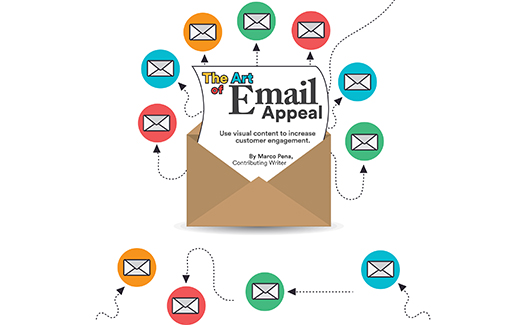April 18, 2016
I recently led a seminar in which I asked the audience a couple of questions about spam email. In the interest of full disclosure, I already knew the answers, but my motivation was to get attendees to think.
The first question was, “How many of you got at least one spam email today?” Not surprisingly, everyone raised their hands. Next, I asked, “How many of you send regular emails to your clients — at least one every month?” This time, only about 20% of the attendees raised their hands. Finally, I asked, “Of those of you who raised your hands, how many of you think that your marketing emails are spam?” Not a single hand was raised.
There’s an art to composing great emails to increase engagement with prospects and clients. One of the key components is visual content. The old adage “a picture paints a thousand words” still holds true, perhaps more so in the digital age, and it succinctly describes how people can read a story more quickly and effectively in a visual image than in a large amount of text. Not only do we recognize meaning more effectively in a visual representation, but we also retain visually acquired information better than text. Recent studies have found that people only remember 10% of what they hear and 20% of what they read, but 80% of what they see and do.
Composing Standout Emails According to The Radicati Group, a market research firm focused on the computer and telecommunications industries, the average business owner receives 84 emails per day (71 are legitimate and 13 are spam) and they send 41 emails a day.
Add to that the average open rate for professional services is 21.21% and, of that, the click-through rate is only 2.75%, and it’s easy to feel like you are wasting your time by sending marketing emails.
While these numbers seem bleak, there are simple ways you can ensure higher open, click-through and conversion rates.
1. Use catchy phrases in the subject line to increase the chances of them opening the email, but don’t be too sales-centric. Studies show that about 64% of people say they open an email because of the subject line.
2. Using “urgent” keywords like “still time” increases the open rate by 15.54%, but stay away from words like “running out.” That kind of subject line negatively impacts open rates by about 3.30%.
3. Keep subject lines between 61 and 70 characters long. If they are too short, they often get dismissed as spam; if they are too long, they will get ignored.
4. It helps if you have done business with an email recipient in the past. Open rates from brands a recipient has done business with and trusts is 69.8%, according to a 2014 study by ExactTarget.
5. Don’t send marketing emails on Fridays. In fact, stay away from Wednesday-Friday. The best days to send these types of emails are typically Saturday, Sunday or Monday.
6. Don’t send emails from your personal email address. Use an email service like Constant Contact or Mail Chimp.
T-Minus 10 Seconds
According to computer user interface and user experience consulting firm Nielsen Norman Group, viewers typically leave a website within 10-20 seconds of viewing it. That is not a lot of time to get your point across. In fact, you have little chance of selling your products if prospects can’t immediately find what they want.
Many companies make the mistake of sending great emails, but all the links go to their homepages. Your visual content should link to the product that enticed the recipient in the first place. It is not good enough to just drive traffic to your website if you can’t convert those opportunities into sales.
Once viewers are on your site, use visually striking images to capture their imagination. According to Statisticbrain.com, eight seconds is the average person’s attention span and an average of only 28% of the words on a website are actually read. Instead of wasting time and money creating text-only webpages, reduce the text and use attention-grabbing items such as videos, images and bullet points.
Consider contracting a professional photographer to take high-quality images for your website or at the very least use good stock art to ensure your content looks professional and is representative of the quality you offer.
Take your business owner cap off and put your consumer cap on. What content entices you to engage with a company? What kinds of visuals are pleasing to you and make you want to take action? If you can answer these simple questions, you can create visual content that will engage your audience.
Marco Pena is business development manager for DecoNetwork. He has more than 17 years of industry experience, ranging from graphic and embroidery design to software development and e-commerce. For more information or to comment on this article, email Marco at mpena@deconetwork.com.
More Build Your Business
April 8, 2024
For anyone trying to build their decorated-apparel business, community involvement is a great way to have a positive impact on your neighborhood and build strong relationships with potential customers and partners.
FULL STORY
April 3, 2024
Market your screen-printing, embroidery, heat-pressing or digital-decorating business’s way to its best year yet by leveraging the power of e-mail and social media.
FULL STORY
April 3, 2024
While the craft of embroidery, screen printing, heat pressing or digital decorating is critical to professional success, it’s only part of the equation. Just as important is getting a handle on the business side of things.
FULL STORY




